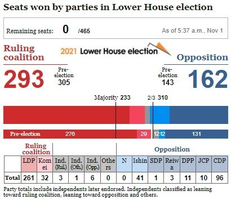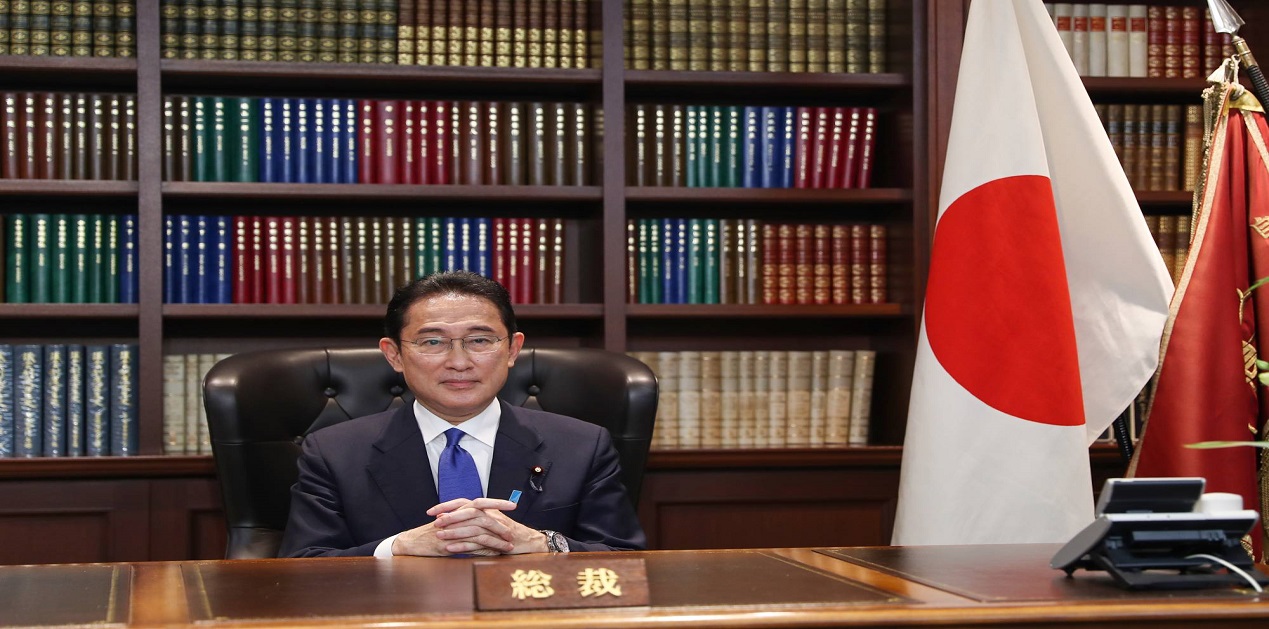The 49th general election of members of the House of Representatives in Japan (Lower House) was held on 31 October 2021, as required by the Constitution of Japan. Voting took place in all Representatives constituencies including proportional blocks, in order to appoint new Members of Diet to seats in the House of Representatives. As was expected, voters reposed faith on the ruling Liberal Democratic Party (LDP) headed by Fumio Kishida, who after succeeding Yoshihide Suga as Japan’s Prime Minister dissolved the Lower House with less than a month in office, and sought a fresh mandate. The outcome showed that Kishida secured a base to govern for the next four years. The voter turnout was 55.33 per cent, above 2014’s record low of 52.66 per cent, which was a post-War record. [1]
Before analysing the challenges that Kishida is going to confront both in domestic and foreign fronts, a brief explanation on the election outcome and which party fared in what way would keep the likely governance in perspective. The following table shows the performance of each party. It can be seen that though the ruling LDP-Komeito combine secured 292 seats, 12 less than its earlier held 305 seats in the 465-member House, it was still way ahead of a stable majority of 262 seats. This will enable Kishida to govern for the next four years without any fear of destabilisation. The mandate will also allow Kishida to secure the chairman’s post of all Lower House standing committees and dominate the membership in those bodies.

This time five opposition parties formed a united front led by the main opposition Constitutional Democratic Party of Japan (CDPJ) hoping to oust the LDP-Komeito ruling coalition. The strategy did not work as the CDPJ itself could not reach its pre-election strength of 109 seats and ended up with 96. Nippon Ishin (Japan Innovation Party), which did not join the CDPJ-led united front and fought as a single political bloc more than tripled its number of seats from the 11 held before the election. [2]
One noteworthy outcome of the election also saw many upsets as a number of veteran lawmakers and political heavyweights failed to retain their seats. Akira Amari became the first LDP Secretary-General to lose to a CDPJ candidate, the first time since the current single-seat electoral system was put in place in 1996. Amari expressed his intention to resign after discussion with Kishida. This was for the first time the 72-year-old Amari lost the election after serving successive 12th term as a lower house lawmaker when Kishida dissolved the chamber on 14 October. Earlier, Amari had served as economy minister but had resigned in January 2016 over graft allegations against him and his secretaries. [3]
Amari's predecessor Toshihiro Nikai, 82, who served more than five years as LDP secretary general and was the oldest candidate in the election, secured his 13th term in the Diet.
Another veteran Nobuteru Ishihara, a former Secretary-General of the LDP, too failed to keep his seat and lost to a newcomer who ran on a CDPJ ticket. [4] Ishihara, the eldest son of outspoken former Tokyo Gov. Shintaro Ishihara, heads a faction of the LDP and served as environment minister and minister in charge of economic revitalization, among other posts.
LDP’s coalition partners Komeito increased its tally from 29 seats it held earlier to 32. Former digital minister Takuya Hirai, and former Olympics minister Yoshitaka Sakurada were also defeated by CDPJ candidates. Former education minister Ryu Shionoya and former justice minister Katsutoshi Kaneda similarly lost to CDPJ candidates who were re-elected. Other prominent figures in the losing list included former home affairs Minister Takeshi Noda and former LDP Secretary-General Makoto Koga. Another CDPJ heavyweight, Ichiro Ozawa, who previously served as a Secretary-General for the LDP and later as president of the now-defunct Democratic Party of Japan, was too defeated. Another in the losing list included former construction minister Kishiro Nakamura. Thus it transpired that the Japanese people were looking for new faces which could bring in new ideas in the governance process.
Another aspect of the outcome that need not be missed is this time fewer women were elected despite a law enacted in 2018 promoting female participation in the political field. Despite this law, the number of female lawmakers came down by 2 with 45 elected in the 465-seat house, thereby falling 0.4 percentage point from 10.1 per cent marked in the previous election. While the LDP elected 20 women among its 259 elected (the figure went up to 261 with LDP support to two male independents after the election), the CDPJ elected 13 out of 96 elected under its banner. [5]
Task Ahead
With this mandate Kishida needs to deliver on his promises to revive the coronavirus-hit economy and deal with regional security threats. The importance of the election result can be measured from the fact that the lower house enjoys special power not available to the upper house and this includes electing the prime minister, passing state budgets and ratifying international treaties. [6] A special session is expected to be convened on 10 November formally electing Kishida. He might tweak the Cabinet formation in a small way but by and large likely to retain all previous ministers with key portfolios.
In the domestic front, the key focus will be to spur economic growth. This includes addressing the issue of income inequality by redistributing the spoils to the middle class under his vision of “new capitalism”. It was widely perceived that Shinzo Abe’s Abenomics policy mix only served to widen income disparities by boosting corporate earnings while workers wages stagnated. Kishida’s political slogan of “promoting distribution” and “new capitalism” strategy aims to address this by redistributing wealth to the middle class but he does not have any specific plan in place now. The business community wants the government to present details about the “new capitalism” economic policy. [7] If Kishida is serious on his promise of “a new form of capitalism”, he needs to focus on reform, rather than needlessly embroil the government in private enterprises. [8]
Another task before Kishida would be restoring public trust that was eroded somewhat during the tenure of his two predecessors – Abe and Suga. The two held power for a total of nine years. Kishida would constantly need the cooperation of the opposition by engaging them in constructive dialogue so that he can effectively implement plans to tackle a range of internal and foreign policy challenges. He has been criticised for listening less and talking more and now it will be a test for him how to keep his promise for attaining “careful and tolerant politics.” [9]
On the foreign policy front, challenges are severe. China remains a constant worry with its belligerent postures on regional issues and by violating global rules. Kishida needs to work together with countries that share common values and concerns to check China’s policy of becoming more muscular. Strengthening the Quad is going to a priority. Alliance with the US shall remain robust. The only bother for Kishida could be getting along with the CDPJ for a working relationship as the latter supports the Japan-US alliance but the JCP calls for abolishing the 1960 security treaty between Tokyo and Washington. China, Russia and North Korea could exploit the situation if the JCP becomes more vocal.
In response to China’s increasing military build-up and North Korea’s nuclear advancement as well as missile threats, Kishida could prioritise building up Japan’s defence capability. The LDP has already made its intentions clear to double defence spending to 2.1 per cent of the gross domestic product, thereby breaching the self-imposed 1 per cent threshold, and also consider acquiring the capability to launch strikes on enemy bases as part of efforts to boost deterrence.
How does one see India-Japan relations during the Kishida tenure? Given the past and convergence of interests on a host of issues and backed by institutional mechanism, one can only see optimism for the future as both countries share common viewpoints on regional issues. At the bilateral level, economic ties shall be deepened, cultural relations be expanded and the win-win situation shall continue. Kishida and Prime Minister Narendra Modi need to speak soon and discuss the significance of exclusion of India and Japan from the AUKUS as both were not consulted before concluding the military alliance and examine whether it complements the Quad or detrimental to their interests. Hopefully such issues shall be taken up during the next summit, besides other issues of mutual interests.
References
[1]https://mainichi.jp/english/articles/20211101/p2a/00m/0na/020000c
[2]https://www.asahi.com/ajw/articles/14472445
[3]https://mainichi.jp/english/articles/20211101/p2g/00m/0na/003000c
[4]https://mainichi.jp/english/articles/20211101/p2a/00m/0na/023000c
[5]https://mainichi.jp/english/articles/20211101/p2g/00m/0na/050000c
[6]https://mainichi.jp/english/articles/20211101/p2a/00m/0na/002000c
[7]https://the-japan-news.com/news/article/0007941994
[8]Duncan Bartlett, “Prime Minister Kishida Needs a Bold Approach Now to Enrich the Country”, Japan Forward, 1 November 2021, https://japan-forward.com/prime-minister-kishida-needs-a-bold-approach-now-to-enrich-the-country/
[9]https://www.asahi.com/ajw/articles/14472705
(The paper is the author’s individual scholastic articulation. The author certifies that the article/paper is original in content, unpublished and it has not been submitted for publication/web upload elsewhere, and that the facts and figures quoted are duly referenced, as needed, and are believed to be correct). (The paper does not necessarily represent the organisational stance... More >>
Image Source:https://www.japantimes.co.jp/news/2021/09/30/national/politics-diplomacy/kishida-win-voters/











Post new comment